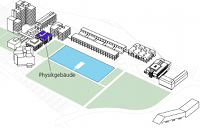Position Indication:
Content

2012 - Dominik Göbl
Interaction of slow light ions with solids: charge exchange and electronic stopping
Projekt zur forschungsbezogenen Weiterbildung: Teilnahme an den Konferenzen
International Workshop on Inelastic Ion-Surface Collisions (IISC)
und
International Conference on Atomic Collisions in Solids (ICACS)
II-SC 19, Frauenchiemsee, Germany
16. – 21.09.2012,
ICACS 25, Kyoto, Japan
21. – 25.10.2012
Dominik Göbl
Contact: vorname.nachname(/\t)jku.at
As a PhD student in the group of Prof. Peter Bauer, I concentrate my research efforts on the investigation of interactions of slow light ions with solid materials. In particular I’m interested in two different phenomena: charge exchange between He ions and solid surfaces and electronic stopping of H and He projectiles.
In the last couple of months, our group was able to obtain important results in both fields: In the field of charge exchange we investigated a special group of materials which is able to neutralize He in a so called quasi-resonant process. Although this process is already known, we were the first group who obtained quantitative data on the efficiency of this process. Additionally we continued the cooperation with Prof. Carmina Monreal (UAM Madrid) which started during my diploma thesis. Here we were able to advance in our understanding of the theoretical description of Auger-neutralization processes.
In the field of electronic stopping power, our group is focussing on band structure effects in electronic stopping. To get a better understanding of the role of d-electrons, we conducted experiments on Ag and Pt targets. Electrons in the d-band of Ag have a finite excitation threshold while the d-band in Pt reaches up to the Fermi edge. From the difference in the stopping behaviour of these two materials, information on the influence of d-band on electronic stopping can be deduced.
A detailed description of the conducted investigations is given in the following abstracts:
- A quantitative investigation of quasi-resonant neutralization of He+ ions at a germanium surface (pdf)
- Auger-neutralization of He+ on Cu surfaces: simulation of azimuthal scans (pdf)
- On the role of d-electrons in electronic stopping of slow light ions (pdf)
I was given the possibility to present our results to a broad audience at two international conferences, which both specialize in one or both of our main research fields: the International Workshop on Inelastic Ion-Surface Collisions (IISC - www.ipp.mpg.de/ippcms/eng/for/veranstaltungen/konferenzen/iisc) and the International Conference on Atomic Collisions in Solids (ICACS - http://icacs25.riken.jp/). On both conferences I had the opportunity to discuss our results with experts in the field, to meet other researches with similar interests and set the ground for future cooperations. Therefore, I want to gratefully acknowledge the financial support from the Wilhelm-Macke Stiftung.


 Audit hochschule und familie
Audit hochschule und familie

